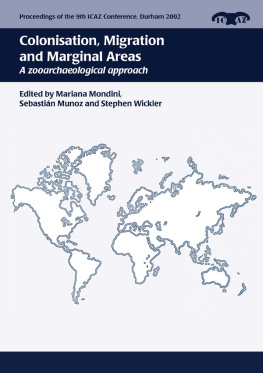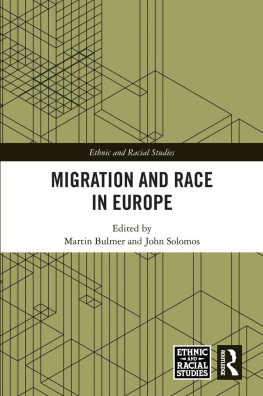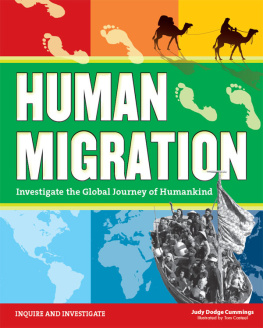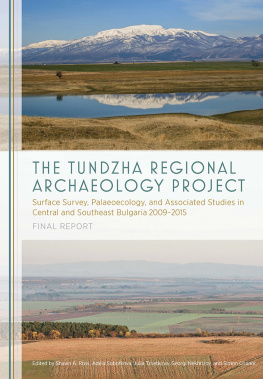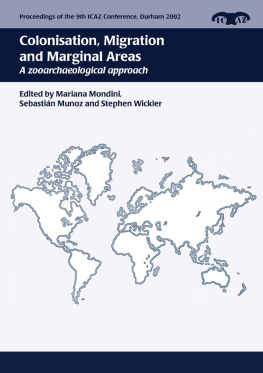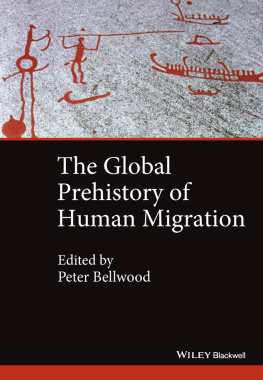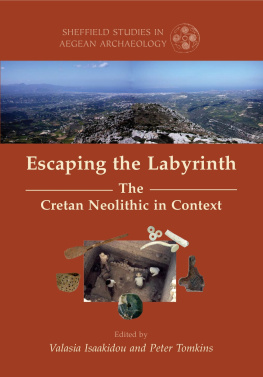
Colonisation, Migration and Marginal Areas
A zooarchaeological approach
Proceedings of the 9th Conference of the International Council of Archaeozoology, Durham, August 2002
Series Editors: Keith Dobney, Peter Rowley-Conwy and Umberto Albarella
Colonisation, Migration and Marginal Areas
A zooarchaeological approach
Edited by
Mariana Mondini, Sebastin Muoz and Stephen Wickler
Oxbow Books
First published in the United Kingdom in 2004. Reprinted in 2017 by
OXBOW BOOKS
The Old Music Hall, 106108 Cowley Road, Oxford OX4 1JE
and in the United States by
OXBOW BOOKS
1950 Lawrence Road, Havertown, PA 19083
Oxbow Books and the individual authors 2004
Paperback Edition: ISBN 978-1-78570-515-1
Digital Edition: ISBN 978-1-78570-516-8
Mobi Edition: ISBN 978-1-78570-517-5
A CIP record for this book is available from the British Library
All rights reserved. No part of this book may be reproduced or transmitted in any form or by any means, electronic or mechanical including photocopying, recording or by any information storage and retrieval system, without permission from the publisher in writing.
For a complete list of Oxbow titles, please contact:
UNITED KINGDOM
Oxbow Books
Telephone (01865) 241249, Fax (01865) 794449
Email:
www.oxbowbooks.com
UNITED STATES OF AMERICA Oxbow Books
Telephone (800) 791-9354, Fax (610) 853-9146
Email:
www.casemateacademic.com/oxbow
Oxbow Books is part of the Casemate Group
Preface
Umberto Albarella, Keith Dobney and Peter Rowley-Conwy
This book is one of several volumes which form the published proceedings of the 9th meeting of the International Council of Archaeozoology (ICAZ), which was held in Durham (UK) 23rd28th August 2002. ICAZ was founded in the early 70s and has ever since acted as the main international organisation for the study of animal remains from archaeological sites. The main international conferences are held every four years, and the Durham meeting the largest ever follows those in Hungary, the Netherlands, Poland, England (London), France, USA, Germany and Canada. The next meeting will be held in Mexico in 2006. The Durham conference which was attended by about 500 delegates from 46 countries was organised in 23 thematic sessions, which attracted, in addition to zooarchaeologists, scholars from related disciplines such as palaeoanthropology, archaeobotany, bone chemistry, genetics, mainstream archaeology etc.
The publication structure reflects that of the conference, each volume dealing with a different topic, be it methodological, ecological, palaeoeconomic, sociological, historical or anthropological (or a combination of these). This organisation by theme rather than by chronology or region, was chosen for two main reasons. The first is that we wanted to take the opportunity presented by such a large gathering of researchers from across the world to encourage international communication, and we thought that this could more easily be achieved through themes with world-wide relevance. The second is that we thought that, by tackling broad questions, zooarchaeologists would be more inclined to take a holistic approach and integrate their information with other sources of evidence. This also had the potential of attracting other specialists who shared an interest in that particular topic. We believe that our choice turned out to be correct for the conference, and helped substantially towards its success. For the publication there is the added benefit of having a series of volumes that will be of interest far beyond the restricted circle of specialists on faunal remains. Readers from many different backgrounds, ranging from history to zoology, will certainly be interested in many of the fourteen volumes that will be published.
Due to the large number of sessions it would have been impractical to publish each as a separate volume, so some that had a common theme have been combined. Far from losing their main thematic focus, these volumes have the potential to attract a particularly wide and diverse readership. Because of these combinations (and because two other sessions will be published outside this series) it was therefore possible to reduce the original 24 sessions to 14 volumes. Publication of such a series is a remarkable undertaking, and we are very grateful to David Brown and Oxbow Books for agreeing to produce the volumes.
We would also like to take this opportunity to thank the University of Durham and the ICAZ Executive Committee for their support during the preparation of the conference, and all session organisers now book editors for all their hard work. Some of the conference administrative costs were covered by a generous grant provided by the British Academy. Further financial help came from the following sources: English Heritage, Rijksdienst voor het Oudheidkundig Bodemonderzoek (ROB), County Durham Development Office, University College Durham, Palaeoecology Research Services, Northern Archaeological Associates, Archaeological Services University of Durham (ASUD), and NYS Corporate Travel. Finally we are extremely grateful for the continued support of the Wellcome Trust and Arts and Humanities Research Board (AHRB) who, through their provision of Research Fellowships for Keith Dobney and Umberto Albarella, enabled us to undertake such a challenge.
Two of the 24 sessions organised included the themes of Colonisation and Migration and Marginal Areas. Since these broad study areas cover much common ground, it was obvious that these sessions should be conjoined for the purposes of publication.
Research into the nature and extent of human dispersal throughout the world has been (and still is) one of the major topics of archaeological research over the last 50 years. Although archaeologists have made much progress in understanding the temporal and geographical extent of large and small-scale human movement and trade and exchange networks, fundamental questions remain largely unresolved and, as a result, numerous, often contradictory, hypotheses abound.
Much of our current understanding of human dispersal and exchange networks is based upon the distribution of culturally distinct objects such as pottery and other artefacts. Scientific techniques such as elemental source characterisation of e.g. stone adzes, basalt and obsidian artefacts, slate and flint, have also been employed not only to demonstrate long-distance voyaging, but also to measure the relative isolation or interaction of human groups. However, in many of these current debates, a potentially important source of information has remained largely unexplored; i.e. the study of animal remains (zooarchaeology). Humans transported not only themselves, but also other organisms by land and sea, both during dispersal events as well as through regular exchange networks. Evidence indicates that a whole spectrum of vertebrate taxa was involved depending on geographic location and time period. Some were moved by accident, others were deliberately transported.
The rapid radiation of peoples around the globe during the Late Pleistocene and subsequent Holocene also brought them into new and often extreme environments, which depending on definitions, could be termed marginal. Studies of human adaptation to these new and challenging circumstances, and their subsequent impact upon them have perhaps a longer tradition of employing zooarchaeological evidence. However, although many sites key to our understanding of this broad theme, have produced often large assemblages of animal bones, in too few cases have these potentially important datasets been used to address issues beyond simple diet and subsistence.
Next page
